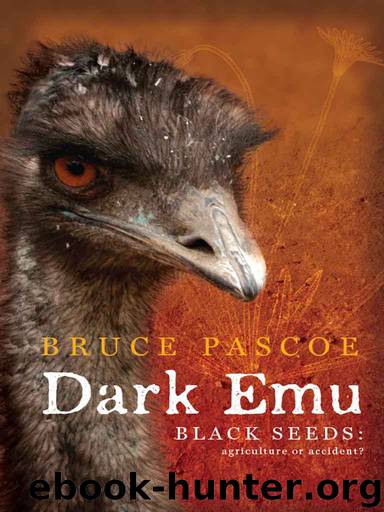Dark Emu by Bruce Pascoe

Author:Bruce Pascoe
Language: eng
Format: epub
ISBN: 9781922142450
Publisher: Magabala Books
Maree Well
PHOTOGRAPH LYN HARWOOD
Stone was also used to construct hides from which to hunt animals and birds, and as protection for sacred items. Ovens and grain stores were built by combining stones with clay mortar. Well covers were made from large slabs of stone ground down to fit neatly over the well in order to prevent animals and litter polluting the water. A huge disc of stone existed on one such well in the Victorian You Yangs right up to the last decade but it was removed and rolled down the hill by vandals.
In 2009 I was shown a small but important well near Maree, South Australia, where small slabs of stone were interleaved to protect the well from animals and reduce water loss through evaporation. The well was opened and closed with reverent ceremony.
Memmott describes buildings made of many materials but most relied on the strength of the dome. In the south-east of the continent whale bone was often used as its curve produced great strength when radiating lengths were bound in the centre and thatched.
Memmott quotes the great Danish seafarer Jorgen Jorgensen’s observations of such buildings on the north-west coast of Tasmania. Jorgensen was an intriguing character in his own right, later returning to Iceland where he became monarch. He was impressed by the beauty and neatness of the buildings he observed in Australia. One of the ‘beehive’ shaped domed huts he noted was over seven metres in diameter.172
In 1974 Bill Mollison reported that, ‘the hut bases, cut into slopes, are visible today on the coast and give ample evidence of their size and structure’.173 Some could accommodate fifteen people and employed timbers bent under steam. Similar structures comprising whale bone beams were reported as far away as the Great Australian Bight where the interstices and roof were made of boughs and dried grass.
In the interior of the continent whole Spinifex plants were employed both in windbreaks and fully enclosed dome structures. The clumps of Spinifex were laid so that the clod and root ball of each plant met at the crown of the house and the leaves extended down the sides. Sometimes the Spinifex was coated with a clay render. These waterproof claddings were observed by many, including Thomson who remarked on the style after his contact with the Pintupi people.174
Jimmy Pike, Walmajarri artist, described the process of cladding similar buildings in the Western Desert with grass and mud.175 Architect, Peter Hamilton, adds an interesting anecdote on the Western Desert designs which may well apply to other regions. Hamilton speculated that the low roof style tended to deter flies because of the darkness within. Other observers commented on this principle from other areas. Flies are a general nuisance in Australia but many of the objectionable blowfly species were introduced into the country with sheep. Even so, the small black bush fly still knows how to make its presence felt.
Download
This site does not store any files on its server. We only index and link to content provided by other sites. Please contact the content providers to delete copyright contents if any and email us, we'll remove relevant links or contents immediately.
| Africa | Americas |
| Arctic & Antarctica | Asia |
| Australia & Oceania | Europe |
| Middle East | Russia |
| United States | World |
| Ancient Civilizations | Military |
| Historical Study & Educational Resources |
The Songlines by Bruce Chatwin(2110)
The Fatal Shore by Robert Hughes(990)
Origins to Eureka by Thomas Keneally(712)
11 The Bear And The Dragon by Tom Clancy(609)
A Commonwealth of Thieves: The Improbable Birth of Australia by Thomas Keneally(595)
Eureka to the Diggers by Thomas Keneally(578)
Australia 1901 - 2001 by Andrew Tink(571)
A Commonwealth of Thieves by Thomas Keneally(558)
Shoot Straight, You Bastards! by Nick Bleszynski(533)
Dark Emu by Bruce Pascoe(526)
The Penguin History of New Zealand by Michael King(496)
Carnivorous Nights: On the Trail of the Tasmanian Tiger by Margaret Mittelbach; Michael Crewdson; Alexis Rockman(491)
James Cook by Peter Fitzsimons(483)
The Book Of Ian Watson by Ian Watson(480)
Venom by Brendan James Murray(479)
The Tall Man by Chloe Hooper(423)
Murder on Easey Street by Helen Thomas(394)
The Golden Country by Tim Watts(389)
Australian History for Dummies by Alex McDermott(363)
